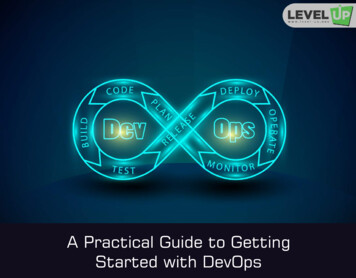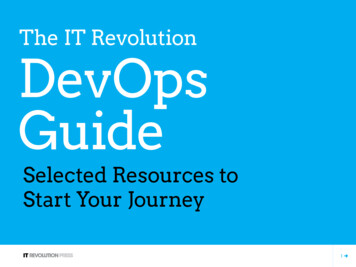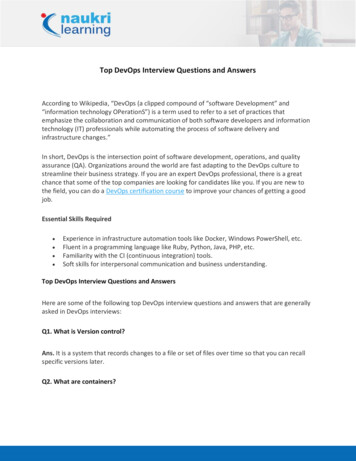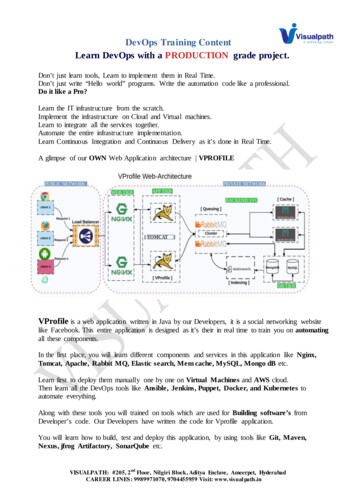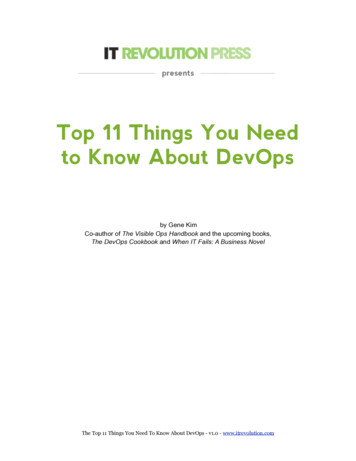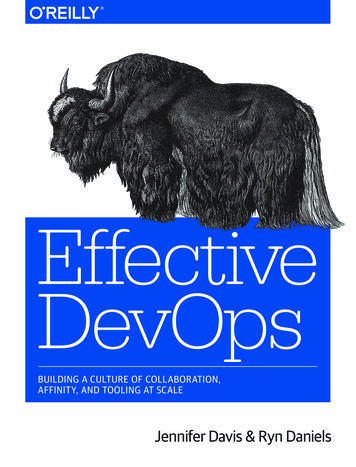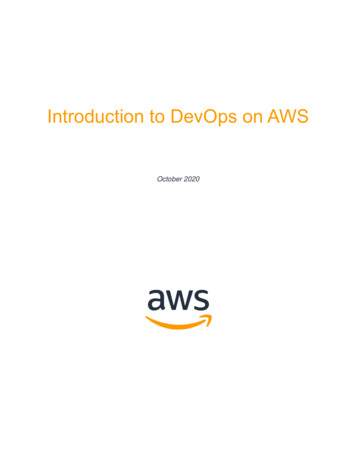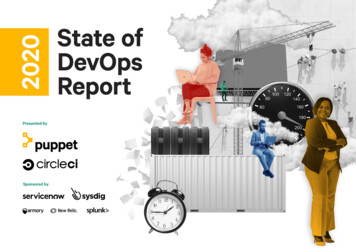
Transcription
ContentsExecutive summaryIntroductionScaling DevOps practices with internal platform teamsChange management in the DevOps eraSecurityConclusionAuthor biographiesWho took the survey36924474950522020 State of DevOps Report presented by Puppet and CircleCI2
Executive summaryExecutive summaryScaling DevOps practices with internal platformsInternal platform usage is widespread. Sixty-three percent of respondents say their companyhas at least one self-service internal platform. Of those with internal platforms, 60 percent havebetween two and four. Almost a third of respondents have 25 to 50 percentof developers using an internal platformHigher levels of DevOps evolution mean moreself‑service offerings for developers. Highly evolved firmsoffer a wide range of self-service capabilities, including:High DevOps evolution correlates strongly withhigh use of internal platforms. Highly evolved firmsare six times as likely to report high use of internalplatforms as firms at a low level of DevOps evolution.Top challenges to providing an internal platform––––CI/CD workflowsInternal infrastructurePublic cloud infrastructureDevelopment environmentsLack oftimeLack ofstandardization––––Monitoring and alertingDeployment patternsDatabase provisioningAudit loggingLack of technical skillswithin the teamA product mindset is key to scaling DevOps andyour platform. Highly evolved firms are nearly twiceas likely to be highly product-oriented as firms in themiddle of their DevOps evolution. Back to Contents2020 State of DevOps Report presented by Puppet and CircleCI3
Executive summaryChange management in the DevOps eraChange management effectiveness increasesas organizations evolve their DevOps practices.Highly evolved firms are nearly three times as likely tohave highly effective change management as firms at alow level of DevOps evolution.Automation makes people more confident their changemanagement is effective. Firms whose employees believe theirchange management is effective are three times more likely toautomate testing and deployment than firms where confidence inchange management performance is low.The most effective change management is achieved byfirms that emphasize: A high degree of testing and deployment automation A high degree of automated risk mitigation Less rigid and much less manual approval processes Writing changes in code Allowing employees more scope to influencechange management DevOps processes and cultureFirms that give people a say in the change managementprocess have better change management. Firms that have high employee involvement in the changemanagement process are more than five times as likely tohave highly effective change management than firms with lowemployee involvement. Firms that focus on automation the most also involve theiremployees the most in their change management process. Firms that have the heaviest and most manual process involvetheir employees the least in their change management process.Highly orthodox approval processes make changemanagement process inefficient. Firms with highlyorthodox approvals are nine times more likely to have highlevels of inefficiency in their change management processthan firms with low levels of orthodox approval.Top challenges to automatingthe change management process Back to ContentsIncompletetest coverageOrganizationalmindsetTightly coupledapplication architecture2020 State of DevOps Report presented by Puppet and CircleCI4
Executive summarySecurity integrationIntegrating security fully into the software delivery processimproves your ability to quickly remediate critical vulnerabilities. Among companies with full security integration,45 percent can remediate critical vulnerabilities within a day. Just 25 percent of those with low security integrationcan remediate within a day.Integrating security fully into the software delivery processleads to providing self-service for security and compliancevalidation. Companies that have fully integrated security are morethan twice as likely to offer self-service for security and compliancevalidation as firms with no security integration. Back to Contents2020 State of DevOps Report presented by Puppet and CircleCI5
IntroductionWe’re in our ninth year of publishing the State ofDevOps Report. During a decade that has redefinedpeople’s expectations for software — speed ofdelivery, quality and security — our ongoing surveyof more than 35,000 technical professionals aroundthe world has deepened understanding of thepractices that let some organizations streak ahead,while others are left in the dust.This year’s survey includes over 2,400 participantsaround the world who work in IT, development,information security and related areas. We recognizethat 2020 was a challenging year to get work done,much less take a survey, so we appreciate everyonewho took the time to provide thoughtful answers. Back to ContentsFor every person who completed the 2020 State ofDevOps survey, we donated 1 to the World HealthOrganization COVID-19 Solidarity Response Fund.We also donated 45,000 — all the funds providedby our generous sponsors — to nonprofits helpingour most vulnerable communities cope with theeffects of COVID-19: WHO COVID-19 Solidarity Response Fund No Kid Hungry Doctors Without BordersThanks to everyone who took the survey and oursponsors — Armory, CircleCI, New Relic, ServiceNow,Splunk and Sysdig — for making this possible.2020 State of DevOps Report presented by Puppet and CircleCI6
IntroductionOver the years, we’ve shown that DevOps practices lead tobetter performance and organizational outcomes. We havelearned and shared the practices and patterns that enableorganizations to evolve, and to release better software faster.Despite the notable progress we’ve witnessed, we havealso seen that most organizations struggle to move beyondthe middle stages of their DevOps evolution. They arerarely able to scale DevOps ways of working beyond thedevelopment, operations, and (sometimes) security teams.Yet some organizations do succeed. They expand DevOpspractices beyond the initial early‑adopting teams, continuingto evolve and improve across the organization. What makesthe difference? The successful organizations enact deeperstructural changes.This year’s DevOps survey has shown two areas ofstructural change that can yield excellent results:a platform approach to software delivery andapplying DevOps principles to change management.When organizations successfully establish a platformmodel for enabling application development, or significantlyimprove their change management effectiveness, theyachieve the goal that DevOps initiatives aim at: faster andeasier delivery of better quality, more secure software. Back to ContentsWhy did we investigate these two areas? The platform model is a fairly new approach to enablingapplication teams. Done right, it simply works, resulting infaster, more efficient delivery of high-quality software thatmeets an organization’s business needs — and at scale. Change management is a common bottleneck thatprevents software from being released at a pace thatallows the business to achieve its goals. Efficient, effectivechange management improves an organization’s ability torelease software on schedule, at the quality and securitylevel the business requires.In Chapter 1, we share our survey findings about theplatform approach, and describe how DevOps principlesinform it. In Chapter 2, we discuss the various approaches tochange management that we discovered among our surveyrespondents, and show how applying DevOps principles canturn change management from a blocker into an enabler offaster, safer software delivery.2020 State of DevOps Report presented by Puppet and CircleCI7
IntroductionExpanding DevOps beyond Dev and OpsIn any organization, creating value through software does notdepend solely on good collaboration between developers andoperators. Nearly all adjacent business functions are ultimately partof the software process, and these need to evolve along with thetechnical delivery teams.Agile, once the exclusive property of engineers, has evolved overthe years, spreading beyond software teams to finance, humanresources, executive leadership teams and more. We hope thatDevOps principles and practices will likewise continue to spreadbeyond the dev and ops teams that first began working with them.This has already happened to some degree with DevSecOps,FinOps, and probably other new manifestations we haven’t seen yet.For DevOps principles to spread further, though, people who careabout the movement need to extend their empathy and passionbeyond the teams that are closest to them, and learn to collaboratewith teams whose functions are further away.Perhaps a few years from now, the term “DevOps” will sound quaint— even fade away — because so many people and organizationshave fully adopted the DevOps principles of collaboration,communication, small-batch iteration, feedback loops, continuouslearning and improvement. We certainly hope so. Back to Contents2020 State of DevOps Report presented by Puppet and CircleCI8
Scaling DevOps practiceswith internal platform teamsDevOps is fundamentally about enabling people to collaborate witheach other towards a common business goal. This necessarily includesthe processes and tooling that teams use, but the conversation oftenglosses over structural issues within an organization that inhibit goodcommunication, the free flow of work, and continuous improvement.Although DevOps practices are well understood and well adopted a decadeinto the movement, we still see that most organizations are struggling toexpand DevOps beyond a few pockets of success. One reason DevOpsoften fails to expand further is that most enterprises are structured in waysthat create misaligned incentives and lack of accountability or ownershipover the outcomes they’re supposed to be driving. Back to Contents2020 State of DevOps Report presented by Puppet and CircleCI9
Scaling DevOps practices with internal platform teamsTeams adopting a set of practices alone cannot furtherDevOps evolution; you have to make the correspondingstructural changes to optimize the way teams work.The DevOps evolution model (see chart at right) shows thatorganizations do not progress to self-service and securityintegration until Stages 4 and 5, after individual people aregiven more autonomy to work without manual approval fromoutside the team (Stage 3).Stage 3 is a critical point of convergence — trust has beenbuilt up in Stages 1 and 2; teams are granted more autonomy;and deployment is no longer a four-alarm fire. At this point,teams can expand their new ways of collaborating acrossmore functional boundaries, beyond Dev and Ops.In Stages 3 to 5 we see a loosening of one-size-fits-all rulesand processes, with an underlying focus on automation.At these stages, automation has expanded beyond solvinglocal problems for a single individual or team to an explicit— and higher — focus on creating value for the business.This is what it means to scale DevOps practices:By empowering individuals and teams to rely on theirknowledge and experience — and by automating — you areable to optimize at an organization-wide scale. You arenow able to focus on eliminating waste across multipledelivery streams, and help the business achieve its goals. Back to ContentsDevOps Evolution erySelf-service Application development teamsuse version control Teams deploy on a standardset of operating systems Teams deploy on a singlestandard operating system Teams build on a standardset of technologies Individuals can do work withoutmanual approval from outside the team Deployment patterns for buildingapps/services are reused Infrastructure changes are testedbefore deploying to production System configurations are automatedProvisioning is automatedSystem configs are in version controlInfrastructure teams use version controlApplication configs are in version controlSecurity policy configs are automated Incident responses are automated Resources are available via self-service Applications are rearchitectedbased on business needs Security teams are involved intechnology design and deployment2020 State of DevOps Report presented by Puppet and CircleCI10
Scaling DevOps practices with internal platform teamsPlatform model: A new-ish approach to scaling DevOpsThe platform model is an approach we’re seeing more and more oftenin the field. It grew out of the idea of product teams (popularized by theDevOps movement), which are responsible for end-to-end delivery of aproduct or service.Broadly speaking, the platform team provides the infrastructure, environments,deployment pipelines and other internal services that enable internal customers— usually application development teams — to build, deploy and runtheir applications.This works very well if you have a single product, or just a few products.But if you have hundreds of products or services, dedicating a productteam to each one is both inefficient and expensive. Imagine 10 teams,each with its own technology stack, toolchain and processes. You’re goingto have all these teams trying to solve similar problems, spending way toomuch time on evaluating technologies, integrating them, maintaining theinfrastructure and more. That’s time that could be better spent buildingand improving the actual products your teams are responsible for.Evan Bottcher’s definition of a digital platform is helpful here: “.a foundationof self-service APIs, tools, services, knowledge and support which arearranged as a compelling internal product. Autonomous delivery teams canmake use of the platform to deliver product features at a higher pace, withreduced coordination.”The lack of standardized technologies and processes creates otherproblems, too: Governance becomes expensive, and nearly impossible to manage. Separate stacks reduce knowledge sharing across the organization. Many of your product teams don’t actually have the skills or expertiseto operate a full infrastructure and application stack. Many developersregard infrastructure operations as a distraction from their real work,so they never really focus on it.While having multiple end-to-end product teams doesn’t scale wellacross large complex environments, a platform model defined by clearpurpose, boundaries and responsibilities does. A platform, built withthe customer in mind, can significantly reduce the toil and overhead ofindividual product teams. Back to ContentsEvan points out that self-service is “a key defining characteristic for a goodplatform . Specifically it should allow for self-service provisioning, self-serviceconfiguration, and self-service management and operation of the platformcapabilities and assets.”The four fundamental team topologiesIf you’re interested in evolving your organizational design and improvingteam interactions, we highly recommend “Team Topologies” a websiterun by Manuel Pais and Matthew Skelton, and also their book by the samename. “Team Topologies” describes four fundamental team types: streamaligned, platform, enabling, and complicated‑subsystem. It also defines threeteam interaction patterns — collaboration, X‑as‑a‑Service, and facilitating— and a team API, which acts as a contract between teams based on code,documentation and user experiences. “Team Topologies” brings togetherdifferent frameworks, models and case studies to provide a functional andteam-centered approach to building complex software systems.2020 State of DevOps Report presented by Puppet and CircleCI11
Scaling DevOps practices with internal platform teamsThe platform model is often associated with cloud native environments,but is also appropriate for many other types of architecture, ranging frommodern to legacy. The primary benefits are:Application teams can be more efficient. They don’t have to be expertsin infrastructure operations or have intimate knowledge of every toolin the toolchain, so they are able to focus on the product. Applicationdevelopers no longer have to wait on a centralized team to provision testenvironments or cloud resources for them, and their resulting autonomyallows them to work much faster.Improved governance. You can’t effectively manage cost, complianceand audit if all your applications run on entirely different infrastructurestacks, using different processes. An effective platform enables efficientIT governance while empowering application teams to deliver quickly.An end to context-switching. Constantly switching attention between anapplication and infrastructure operations is a huge drain on productivity(and creativity too). Both individual workers and teams are better offwhen they can concentrate on their own particular context. For a deeperdive into these two different contexts and how the teams interact, see thesidebar at right, Platform and application: two different contexts.Continuous infrastructure improvement. A common platform that offerscustomer-oriented solutions rather than just raw access to infrastructuregives your organization more flexibility. Consumers of the platform arenot tied to specific implementations of your infrastructure stack, so theplatform team can iteratively replace and upgrade components, andneeds to interact only minimally with application teams. Back to ContentsPlatform and application: two different contextsMost software developers and operations engineers understand thatswitching back and forth between two contexts is a huge cognitive drain.There’s a good reason for this, apart from the normal human challenge ofcontext-switching: the details and mindset of each realm are so different,they call on completely different knowledge and experience sets.The platform team, as the builder and manager of the platform, hasspecific knowledge of infrastructure operations and the centralized toolsthey manage. The platform team’s context includes monitoring andmanaging performance; current load on the platform and planning forchanges to that load; all changes to storage or the network; issues with thehypervisor; working with application schedulers, database layers and more.The application team’s knowledge and context are completely different.They build, deploy and monitor application components, plus any appinfrastructure that they provision themselves and deploy on the platform.An application team’s context includes a wide range of considerations,including customer needs, requirements, values and dependencies.The team also has technical considerations such as the app’s relationshipto other applications; knowledge of the codebase and its current state;and knowledge of current features, as well as those under development orabout to be deprecated.Having a platform team that’s distinct from the application team meanseach group is able to make decisions quickly, based on the context theyhave. That’s a big part of why the platform model enables faster softwarethroughput at a higher level of quality.2020 State of DevOps Report presented by Puppet and CircleCI12
Scaling DevOps practices with internal platform teamsUse of internal platformsIn our discussion of platforms, we use the term "internal platform" to meanone that's been built by and for the organization. We're distinguishingthese from platforms that are supplied by outside vendors — for example,many people think of AWS or other IaaS offerings as "platforms.” In oursurvey, we defined platform teams as those that are responsible formaintaining a self-service platform other teams use to build and deliverapplications or services.Does your organizationuse internal platforms?We asked two questions to measure an organization's use of internal platforms: What percentage of your developers use self-service platform(s)? Which services are available for self-service?We found platform use is pretty widespread amongst our survey respondents.Sixty-three percent said they had at least one self‑service internal platform.Of those who had internal platforms, 60 percent had between two and four.Almost a third of those with internal platforms had 26 to 50 percent of theirdevelopers using a platform.How many internal platformsdoes your organization 1%10%7%6%0%10%6%4%5% Back to Contents31%30%25%No37%What percentage of your developersuse internal platforms?123456783% 3%9107%5%0%1-10%11-25%26-50%51-75% 76-100%2020 State of DevOps Report presented by Puppet and CircleCI13
Scaling DevOps practices with internal platform teamsPlatform use and DevOps evolutionWe found a strong relationship between DevOps evolution and the useof internal platforms. Highly evolved firms are almost twice as likely asmid‑level organizations to report high usage of internal platforms, and aresix times more likely to report high usage than low-level organizations.This finding mirrors Stage 5 of the DevOps evolution model, whereself service is a key practice enabled by a foundation of standardization,automation and team autonomy. The underlying structural changes neededto reach Stage 5 reduce complexity in the technology stack, automateaway a lot of toil, and reduce handoffs between teams — all while buildinga high degree of trust. These are all the necessary components for buildingan internal platform that can deliver higher value for the organization.Still stuck in the middleIn our 2018 State of DevOps Report, we set out to understandhow organizations evolve as they progress through theirDevOps journey. The analysis produced a five-stage evolutionmodel (see page 10), with each stage composed of keypractices that define it. We grouped organizations into high, midand low levels of DevOps evolution based on how frequently thekey practices were employed.Once again, we found that the vast majority of firms surveyedthis year (79 percent) are in the group we characterize asmid‑level on the DevOps evolutionary scale — the same as thelast two years. Sixteen percent of the overall sample were in thehigh group, an increase of two percentage points over last year.Use of internal platforms and level of DevOps evolutionLow DevOpsevolution% High use of internal platforms50%48%100%High 2080%40%60%30%40%25%20%10%Mid-level DevOpsevolution20%0%8%0%Low Back to ContentsMid-levelDevOps evolutionHigh2020 State of DevOps Report presented by Puppet and CircleCI14
Scaling DevOps practices with internal platform teamsPlatform as productThe platform team isn’t meant to be an ivory-tower-siloed cadrethat prescribes all architectures, functionality, tooling and more. Theplatform team’s job is to provide core capabilities that make it easierfor their customers — that is, other teams — to get work done andachieve their goals, as well as those of the overall business.An internal platform is a product, not a projectIn our experience, it rarely works to require use of the platformwithout first collaborating with internal customers to understandtheir needs. Paul Ingles, CTO at RVU, explains how his company hasmeasured the success and effectiveness of platform teams over time.There’s a common tendency in technical organizations to tap a limitedpool of exceptionally skilled people who are well-versed in softwareengineering practices, infrastructure as code, continuous delivery, APIsand more. They’ll be tapped to put together the platform, and then,as soon as there’s another important demand, they’ll be pulled off theplatform team and put on the new urgent thing.We never mandated the use of the platform, so setting keyresults for the number of onboarded teams forced us to focuson solving problems that would drive adoption. We also look fornatural measures of progress: the proportion of traffic servedby the platform, and the proportion of revenue served throughplatform services are both good examples of that.— From an interview with Paul Ingles at TeamTopologies.comYou have to make the platform a compelling option. Applicationteams should want to use the platform because it’s easier and morecost-efficient than building and maintaining their own. Back to ContentsThe biggest mistake we see is organizations treating (and funding)platform development as a project. Just like any other product team,a platform team needs longevity, consistency and a commitment frommanagement to be fully successful.Don’t do this. The platform team should not be viewed as fungible. If youwant your platform approach to work for the long term, you should getyour organization to commit to the platform as a product, one that willneed and deserves ongoing development and funding.Give this product time to be developed, tested, rolled out and iteratedon. Over the longer term, you’ll build a competency that will become aserious competitive advantage for rolling out future revenue-producingproducts that can drive your business forward.2020 State of DevOps Report presented by Puppet and CircleCI15
Scaling DevOps practices with internal platform teamsSo what makes a platform a product? First and foremost, a platformshould be built to help deliver global optimization and efficiency atscale. Here are some suggestions for doing that.Think self-service and API first. The key characteristic of a platformproduct is self-service capabilities consumed via an API. This includesinfrastructure, test environments, deployment pipelines, monitoring, andmore. The platform team provides an interface between the underlyinginfrastructure and tooling and the teams consuming those services,enabling application teams to focus on building their products insteadof nitty-gritty implementation or operational details. Self-serviceenables developers to work at their own pace without having to makerequests and wait for fulfillment.Start locally but build globally. Rather than trying to build the entireplatform in one go — based on unverified assumptions about whatyou think application teams need — start with a localized solution andembrace a lean product management approach. Often an applicationteam will develop a good solution for themselves that can be used bymore teams. Working with an existing solution can help drive adoptionby enough teams to provide the feedback you need to further developfunctionality that will eventually serve multiple teams.Focus on developer experience and flow. We can’t stress enough thatempathy is a critical skill set. Empathy means understanding someone’sposition, and it’s impossible to build a good product without havingempathy for your user. We’ve seen platform teams adopt techniquesfrom the UX discipline, such as empathy maps, to understand theircustomers’ needs and pain points. Twilio’s platform team surveys theirdeveloper team to ensure that devs are satisfied with the services theplatform provides, and to continuously improve platform services. Back to ContentsEvangelize. “If you build it, they will come” is a fallacy when it comes tobuilding products. Evangelism is critical to the success of any product.You have to demonstrate the capabilities of your platform in a way yourcustomers can relate to. You also have to keep developers informed ofchanges and updates, publicize upcoming enhancements, and publiclyreport metrics on usage and successful outcomes of the product.Continuously invest in the product. A platform is not a one-and-doneproject. Once you’ve assembled a platform team, commit to keeping it inplace so they can continue to develop and improve the platform, meetingnew organizational needs as they arise.Turning a local solution into a global one— From “Product for Internal Platforms” by Camille Fournier on MediumDon’t be ashamed to take over a system from a team that built it withthemselves in mind, if that system seems to be the right general concept forthe wider company. I did this when I built a global service discovery solutionlong ago. Another team had first identified the problem and created theirown version of a solution using ZooKeeper. The solution was fine for theirneeds, but didn’t solve the general needs of everyone at the company forglobal scaling. So I took over the idea of the project, and turned it into trueplatform infrastructure, built for a big company and not just one team therein.There were plenty of product decisions to make as part of that work, but thecore identification of the problem as worth solving was done for me. There isa lot of interesting work in taking a solution that is locally optimized andturning it into something that can be used by a diverse set of applications.2020 State of DevOps Report presented by Puppet and CircleCI16
Scaling DevOps practices with internal platform teamsProduct mindsetWe wanted to test one of our core hypotheses: The more you treatyour platform as a product, the more likely your platform is to succeed.In order to understand whether platform teams exhibit a product mindset,we asked survey participants whether: The platform team gathers requirements from internal stakeholders Someone on the platform team acts as a product manager forthe platform(s) There is a roadmap for the platform The platform team provides onboarding help The platform team tests new capabilities with the teams that will use themThe more a respondent agreed with these statements about theirplatform team(s), the higher their score for a product mindset.DevOps evolution and platform team behaviorNot product-oriented100%80%7%21%60%40% Back to ContentsHighly 9%Mid-levelDevOps evolutionHighWe found that organizations whose DevOps evolution has reached anadvanced level are nearly twice as likely to be highly product-orientedas companies that are in the middle of their DevOps evolution.Treating your platform as a product means that from the first, youdo the things any good
Back to Contents 2020 State of DevOps Report presented by Puppet and CircleCI 10. The platform model is an approach we’re seeing more and more often in the field. It grew out of the idea of product teams (popularized by the DevOps move

